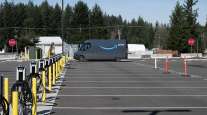The Idaho Statesman
Inside an Amazon Last-Mile Delivery Station
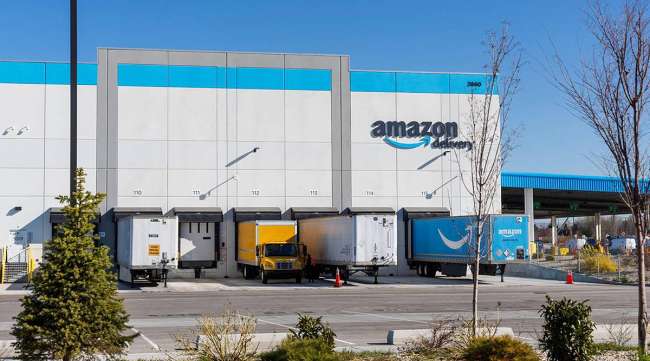
[Stay on top of transportation news: Get TTNews in your inbox.]
MERIDIAN, Idaho — At precisely 9:50 a.m. on April 2, a fleet of more than a dozen navy blue vans marked with the Amazon smile logo pulled into a six-lane loading dock at the company’s new delivery station.
The drivers turned off their engines and swung open their sliding doors, but they didn’t dare hop out.
Instead they stood there, awaiting a whistle from a traffic controller that would signal they could safely begin filling their vans with the day’s deliveries — mostly small to medium-size boxes to land at homes and businesses from Meridian to Fruitland.
Each driver has a designated route and is allotted 20 minutes to pack up and go. Then more vans pour in.
“This area is where all the magic happens,” said Jacob Abundis, senior station manager, during a tour of the 144,000-square-foot building, a bit larger than a Target.
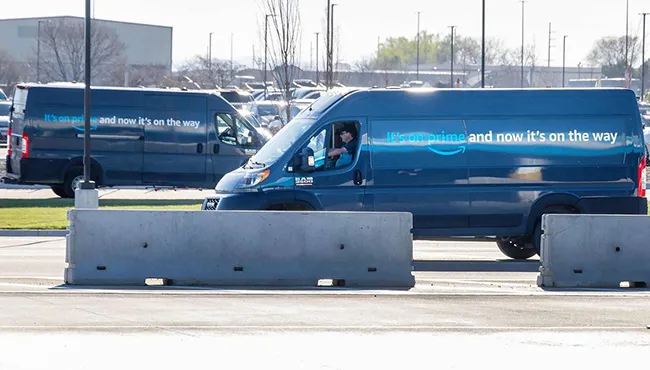
Driver associates pick up packages for their routes. Amazon contracts with four providers for their delivery drivers. (Sarah A. Miller/The Idaho Statesman via Tribune Content Agency)
The new delivery station processes about 40,000 to 50,000 packages a day — and can handle even more during peak times, such as the holiday season in December and Prime Day in July, an annual event where members can get discounts on certain products. The station was built to handle up to 80,000 packages a day.
“As we build our customer population, we can continue to ramp up and expand our delivery services,” Abundis said.
Before the first wave of drivers loaded their vans, a second series of vans drove uniformly into the bay, parking one after another in rows of four in a launch pad dubbed “bravo.”
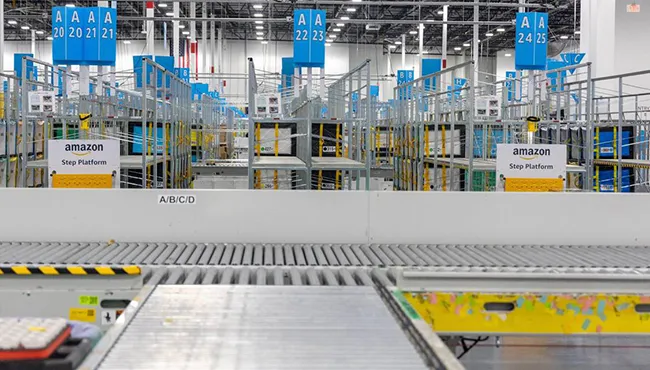
Workers move packages from a conveyor belt into “stow bags,” which are then loaded into tall metal crates called go-carts. (Sarah A. Miller/The Idaho Statesman via Tribune Content Agency)
Amazon contracts with roughly 400 third-party drivers just at that delivery station, about three-fourths of a mile from Interstate 84’s Ten Mile interchange. It’s a “last-mile” pickup point, the final leg of the entire delivery process that starts at a fulfillment center, like the behemoth center about 3 miles to the west that is impossible for motorists on nearby I-84 to miss.
The part- and full-time employees who work inside, more than 200 of them, come from all walks of life, said operations manager Clint Burr, a U.S. Navy veteran.
They mainly move packages from a conveyor belt into “stow bags,” which are then loaded into tall metal crates called go-carts. The workers take care in rolling several of the carts into grids marked with blue tape on the concrete floor. If a disproportionate quantity of small boxes, or large boxes, makes it into one grid, the entire process could be disrupted, according to Sam Bailey, economic development policy manager at Amazon.
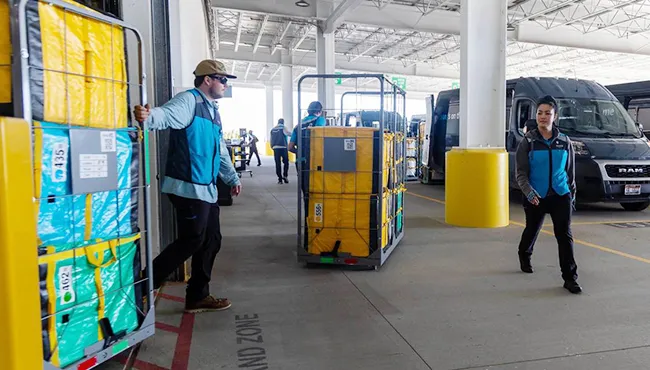
Driver associates pick up packages for their routes at Amazon’s delivery station in Meridian, Idaho, April 2. (Sarah A. Miller/The Idaho Statesman via Tribune Content Agency)
Employees work 10-hour shifts, including two 15-minute breaks and a 30-minute lunch, and earn at least $15 an hour, the company’s minimum wage.
Some of the more common items that move through the warehouse are crock pots, air fryers, paper towels, toilet paper, dog food and cat food, Abundis said. He pointed to a stack of boxes on the floor. One box contained a camping cot, another a set of gardening tools. Many products change with the seasons.
The online retailer held a ribbon-cutting for the site April 2 with a dozen or so community leaders and municipal representatives in attendance. The delivery station first came online in September.
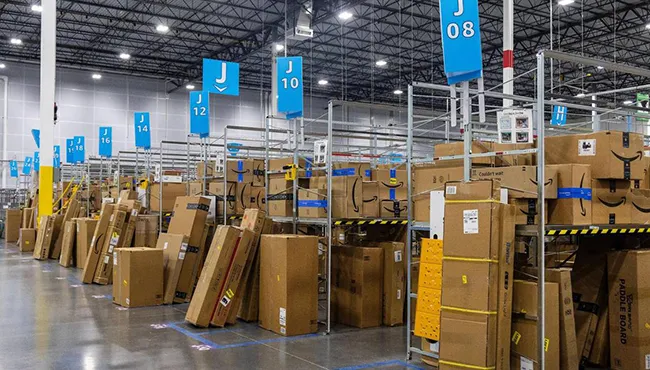
The Meridian station was built to handle up to 80,000 packages a day. (Sarah A. Miller/The Idaho Statesman via Tribune Content Agency)
Abundis touted the company’s recycling program for wood pallets and other waste. He also touted Amazon’s programs for various diversity groups like Latinos, veterans and people with disabilities. Bailey talked about employee benefits. Each worker gets health insurance and the option to join a 401(k) with up to a 4% match on their first day. After 90 days, they can attend college, and Amazon will pay for it.
Greg Hewitt of DHL Express considers whether the trucking industry is prepared for a greener future. Tune in above or by going to RoadSigns.ttnews.com.
“We don’t require employees to study something that will be done working out on the floor,” Bailey said. “They might be working, getting paid, having their benefits and working towards a bachelor’s degree in nursing. At the end of their degrees, they’re going to say to Amazon, ‘Hey, thanks. I’m out of here. I’m going to work at this hospital.’ That’s just fine. They don’t have to pay Amazon back, and they don’t have to stay with us for a designated amount of time.”
The Meridian delivery station is one of several Amazon has been setting up around the Treasure Valley. The company opened its first in 2018 in Nampa and its second in 2019 near the Boise Airport.
Plans for the Meridian station were delayed in 2022 after Amazon said it had overbuilt and had excess capacity after a pandemic-induced online-buying frenzy eased. At one point, it was unclear whether Amazon still intended to occupy the space.
Amazon.com Inc. ranks No. 9 on the Transport Topics Top 100 list of the largest private carriers in North America.
Want more news? Listen to today's daily briefing below or go here for more info:
Distributed by Tribune Content Agency, LLC





